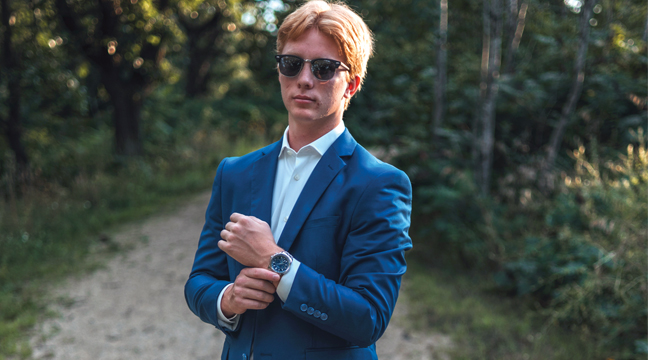The new Winter Lecture Series at the Sherburne History Center (SHC) in Becker was launched Tuesday afternoon, with a small but appreciative audience braving the very cold temperatures to witness the event. The first program was titled “Early 20th Century Fashion: A Reflection of Social Values”. The presenter was SHC program coordinator and St. Cloud State University graduate student Karah Hawkinson.
Her interest in fashion as history began while she was working as an intern at the Anoka County Historical Society, where she cataloged and described clothing items from the previous century. Children’s clothing was an area of interest in her research as well, and she began her presentation with an image of a child’s formal portrait, with long hair, wearing a white dress and patent leather shoes and holding a wide-brimmed hat. Audience members were surprised to learn that it was a portrait of future U.S. President Franklin D. Roosevelt, taken near the end of the 19th Century.
Hawkinson’s lecture revealed that, in the 19th and early 20th centuries, there was no particular mode of dress to separate boys and girls. Both genders wore a dress or shift up until that age, she said, which made diaper changing easier, and also increased mobility for toddlers learning to walk.
Blue and pink for boys and girls was a 1950’s invention, she said, with white being the favorite color for many children’s clothes because of bleach. The “Cleanliness movement” of the time led parents to bleach clothing to kill germs, and white fabrics did not fade or run in the wash when bleached. White was also a favorite color of the wealthy, such as the image of the Russian royal family shown, which meant that one had the income to “afford to be clean”.
Wars and social upheaval were reflected in clothing designs, Hawkinson noted, with the severe wasp-waisted designs inspired by the mandatory corset around the turn of the 19th Century and personified by the fictional “Gibson girls” drawings of feminine perfection. After WW I, these were replaced by the “Flapper” girls thin fabric dresses, smaller hats and a greater sense of freedom. Men’s suits used a great deal of fabric, the double-breasted jackets and wide cuffed pants as far from the look of their military uniforms as they could get. After the Roaring 20’s, society and dress divided sharply among the “haves and the have-nots” in the Great Depression, with the wealthy draped inelegant fabrics, while the majority made do with far less fabric in suits and clothing for both genders, as well as “making do” with any available fabrics, including flour sacks designed for the purpose.
WW II saw rationing of wool and silk for the war effort, and the rise of man-made fibers in civilian clothing. Suits became single-breasted to save fabric, and people again “made do” with the clothing they had. The “zoot suit” was popular among Latino males in the southern California area, a protest garment which showed that they were not going to support the war effort if they were to remain “second class” citizens afterwards. The style features an extravagant amount of fabric, with very wide pants cuffs and long, double-breasted jackets.
Hawkinson said that the end of WW II brought about an explosion in fashions, as rationing ended and women expanded their horizons after taking on a major role in the wartime workforce. Fabric was available, as was money, and women began to appear wearing pants, including blue jeans, big skirts, puffy sweaters and cocktail dresses, while more fabric was the rule in men’s suits as well. The rise of television led the rise of fashion after the war, Hawkinson said, as it was also a way to demonstrate the new “American” style of success in our “Cold War” with Russia.
The next lecture in the series will take place on Tue., Jan. 21 at 2 p.m. at the SHC. Hawkinson noted that several guest lecturers are lined up to give presentations during the three-month series, and the final January program has yet to be finalized. Each session includes time for “coffee and conversation” among audience members, staff and presenters, she said.
Additional programs are scheduled for Feb. 11 and 25, and March 11 and 25 as well. The SHC is located at 10775 27th Ave AE in Becker, MN, call (763) 261-4433 for more information or go on-line at www.sherburnehistorycenter..org.









